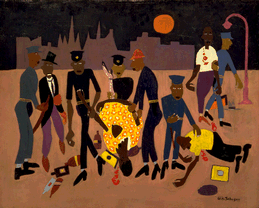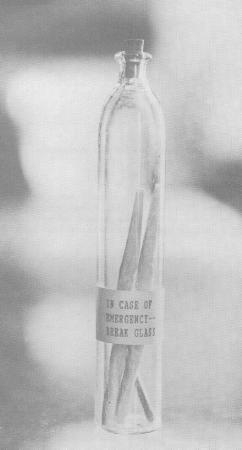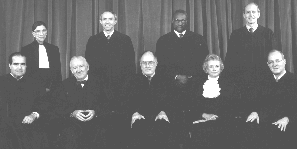The case is Richards vs. Wisconsin, 96-5955.
"New York Drug War Results Questioned"
By Tom Hays
 NEW YORK (AP, March 24, 1997) - Outside the Great Wok, a spindly man in bright yellow sweatpants looks both ways before pushing his hand down a fist-sized hole in the sidewalk. A few seconds later, he shuffles away.
NEW YORK (AP, March 24, 1997) - Outside the Great Wok, a spindly man in bright yellow sweatpants looks both ways before pushing his hand down a fist-sized hole in the sidewalk. A few seconds later, he shuffles away.
That the deal for crack cocaine happened at all is a sign that New York City's war on drugs hasn't shut down the narcotics trade. Instead, some dealers have moved to the suburbs or gone underground - in this case, to a basement extending below a crumbling Brooklyn sidewalk fronting a dingy Chinese restaurant.
"Have (the dealers) quit and gotten 9-to-5 jobs? No," said Capt. Kevin Perham, a commander involved in the crackdown. "But we've made it very uncomfortable for them. ... They're going to pretty great lengths not to deal on the street."
It's been nearly a year since police began an expensive crackdown on dealers in north Brooklyn, where the drug trade was blamed for fueling up to 40 percent of robberies, shootings and other violent crime. What followed was a year of undercover stings, surprise searches and stepped-up street patrols.
The effort is part of Mayor Rudolph Giuliani's campaign against prostitution, panhandling, graffiti and other "quality of life" crimes. Critics say targeting drug peddlers without addressing problems that feed demand - addiction, poor schools, unemployment, broken families - will have no lasting impact.
"My fear is that while dealing is less visible in some places, it's more visible in some new area," said Monsignor John Powis of St. Barbara's Roman Catholic Church. "It still appears that anyone who wants drugs can get them, and rather easily."
Allan Clear, head of the drug addict advocacy group Harm Reduction Coalition, said the police strategy won't work: "Eradicating drugs is a utopian dream. It's not going to happen."
Police say they have made progress, pointing to 1996 statistics from the targeted precincts - narcotics arrests up 16 percent; reports of serious crime down 22 percent; shootings down 23 percent; robberies down 14 percent.
It isn't cheap. The drug battle in Brooklyn is expected to cost the city $30 million this year and next. There are similar plans for other parts of the city.
In one Brooklyn neighborhood, where dealers eight years ago executed a mother for tipping police, a once-thriving heroin trade appears dead after police arrested 50 people in a raid last year.
Steve Martin, 34, said the days are over when he had to say "excuse me" to dealers loitering on his stoop or worry about letting his five children out to play. He credits the police.
"They've stopped all that crap," Martin said.
There are indications that some of the drug suppliers have moved out of town, said Anthony Senneca of the city's U.S. Drug Enforcement Administration office. There have been large drug seizures in the suburbs, including 1,240 pounds of cocaine last year in Westchester County, north of New York City.
But the hole in the Brooklyn sidewalk remains, a sign of dealers' determination. Police have filled it with cement and sealed off the basement, but dealers have broken in and poked new holes.
Authorities admit they can't stop drug sales as long as there are buyers. But they argue that changing the way dealers do business is a worthy goal.
"It's not victory," Senneca said. "But we're winning one battle."
"School Suspends Students For Tasting Alka Seltzer"
BREMERTON, Wash. (AP, March 21, 1997) - Fifteen middle school students were suspended for three weeks for tasting Alka Seltzer on campus in violation of their district's zero-tolerance drug policy.
Even bringing the antacid to school is a violation of the policy, Assistant Superintendent Mariwyn Tinsley said Thursday.
Austin Hicks, a sixth-grader at Mountain View Middle School, said he tasted the broken antacid tablets because a friend told him they were candy. "After lunch I got called into the office" and suspended, he said.
His mother, Darla Hicks, said the district needs to keep things in perspective. "This is not cocaine, this is not LSD or marijuana or anything like that" she said.
The students can opt for a three-day suspension and attend drug-awareness classes and counseling instead.
Teen Smoking Up 30 Percent
As Liggett agrees to new warnings, a study questions effectiveness
Research finds many adolescents don't read labels.
Nicotine is found to be the key obstacle to quitting.
The Philadelphia Inquirer, March 21, 1997
By Robert S. Boyd
Inquirer Washington Bureau
 WASHINGTON - Will tougher cigarette warnings work?
WASHINGTON - Will tougher cigarette warnings work?
The Liggett Group's agreement to mark its packages with a warning that cigarettes are addictive comes after 30 years of increasingly somber cautions about the danger of tobacco.
During that time, cigarette smoking has dropped by half among adult males and by one-third among adult women. But it is increasing sharply among teenagers, when the habit is usually picked up.
In fact, teenage smoking increased by 30 percent from 1991 to 1995, according to a study published yesterday by the Stanford University School of Medicine.
"Sizable proportions of adolescents are not seeing, reading and remembering cigarette warning labels," said the study, which surveyed 1,700 high school freshmen in San Jose. "Knowledge of warning labels was not associated with subsequent decreased smoking."
The labels now say that smoking causes cancer, emphysema and other diseases, but do not mention addiction.
Researchers say that three out of four people who start smoking become confirmed addicts, and that 90 percent of those who try to quit each year fail. [Contradicted by information at http://www.pdxnorml.org/Gazzaniga_excerpt.html - ed.]
A major part of the reason is that nicotine is as addictive as cocaine and heroin, and even more habit-forming than alcohol, according to scientists who study addiction. [Contradicted in part by the information at http://www.pdxnorml.org/NYT_addictive_080294.html - ed.]
Using modern electronic brain-scanners, researchers can see how chemicals in tobacco smoke permanently change the way brain cells, called neurons, communicate with one another. The changes make it extremely difficult - and often impossible - for people to quit.
"Nicotine meets all the criteria of a highly addictive drug," said Jack Henningfield, an expert on drug and tobacco addiction at Penny Associates in Baltimore.
Until a half-century ago, tobacco was considered neither harmful nor addictive. By the end of World War II, it was widely accepted that cigarettes were unhealthful, but not nearly as bad as hard drugs. Smokers called them "coffin nails" as they cheerfully puffed away.
But during the 1970s, researchers began to unravel nicotine's addictive powers. In 1988, President Ronald Reagan's surgeon general, C. Everett Koop, issued a 618-page report declaring that "cigarettes are addicting in the same sense as are drugs such as heroin and cocaine."






